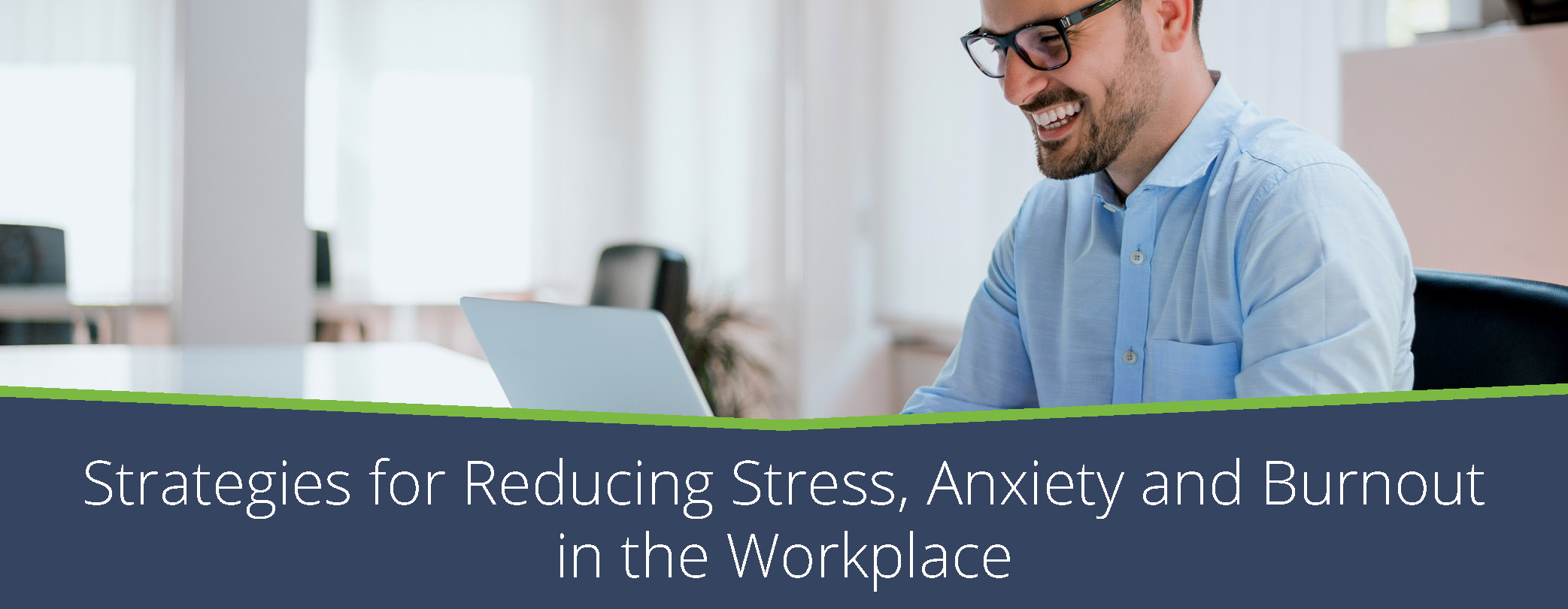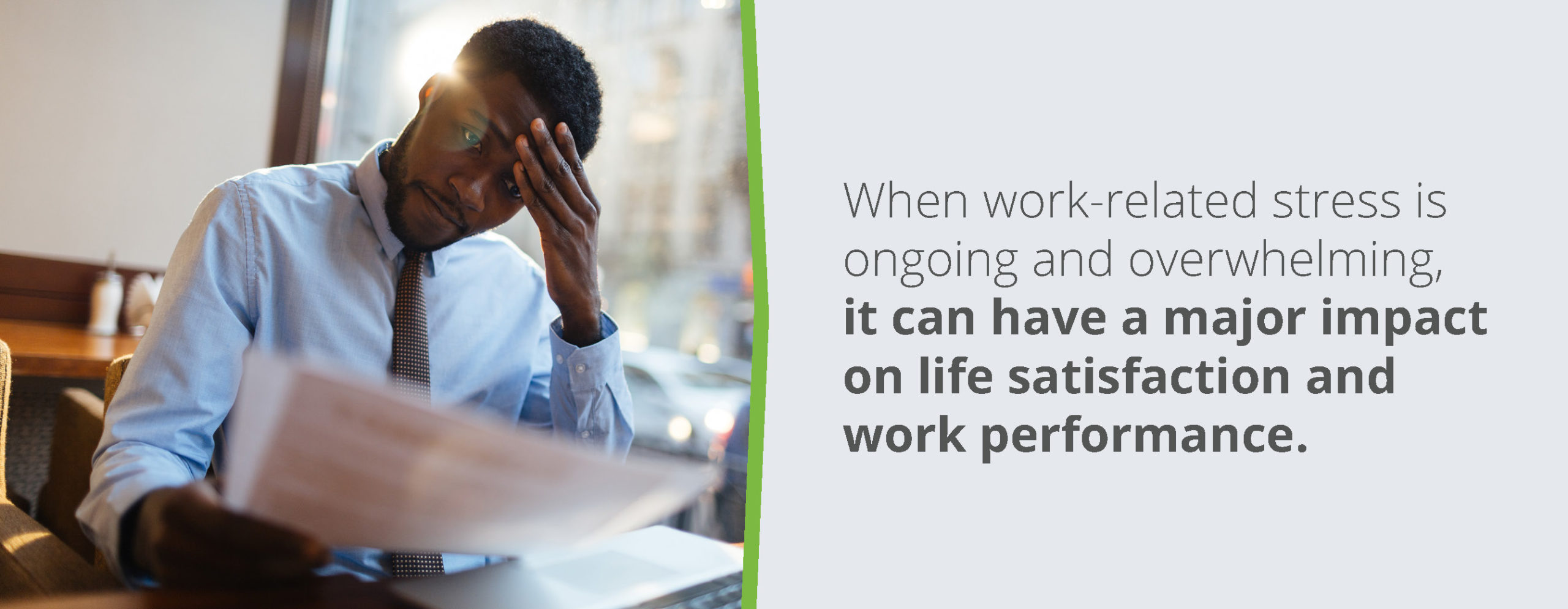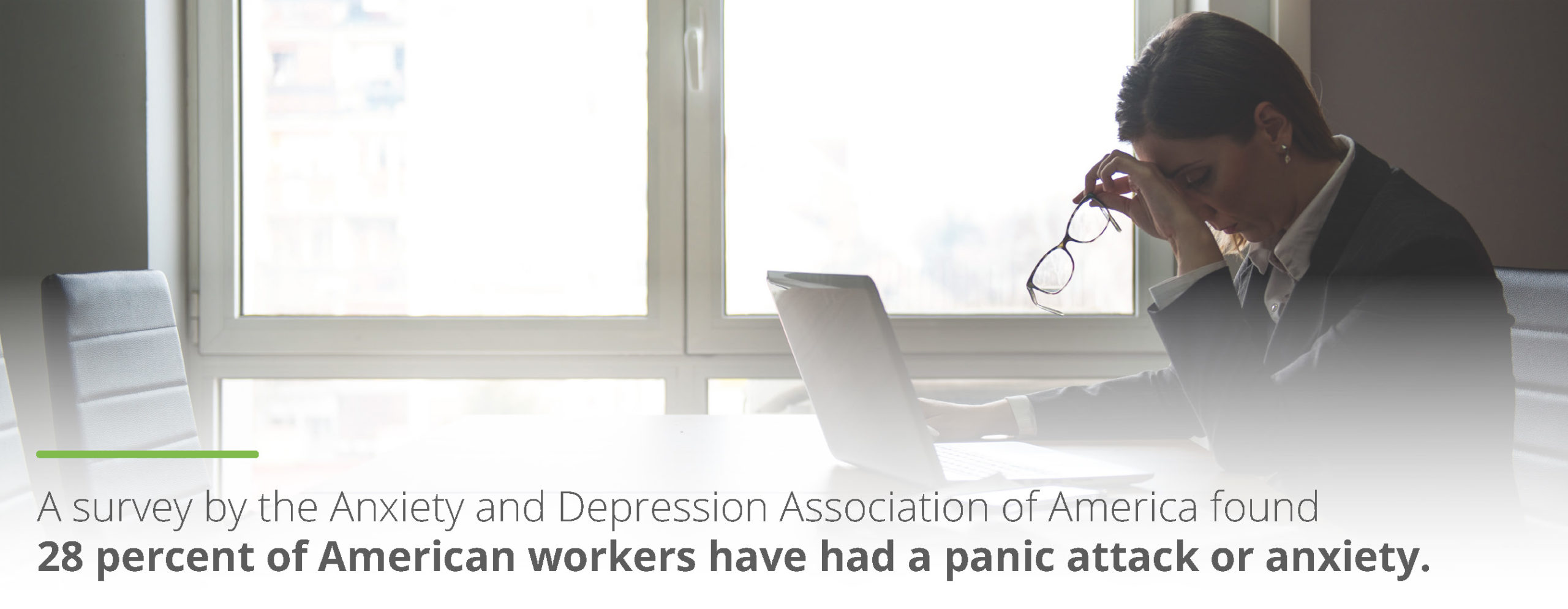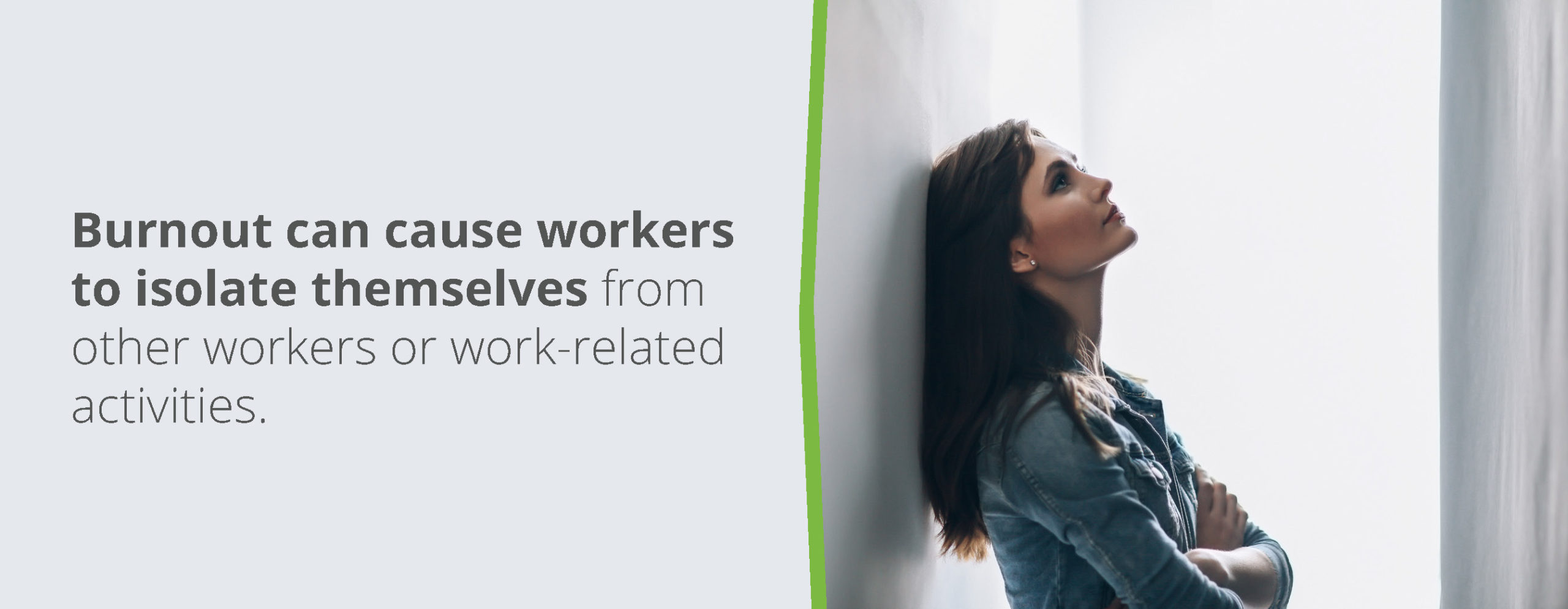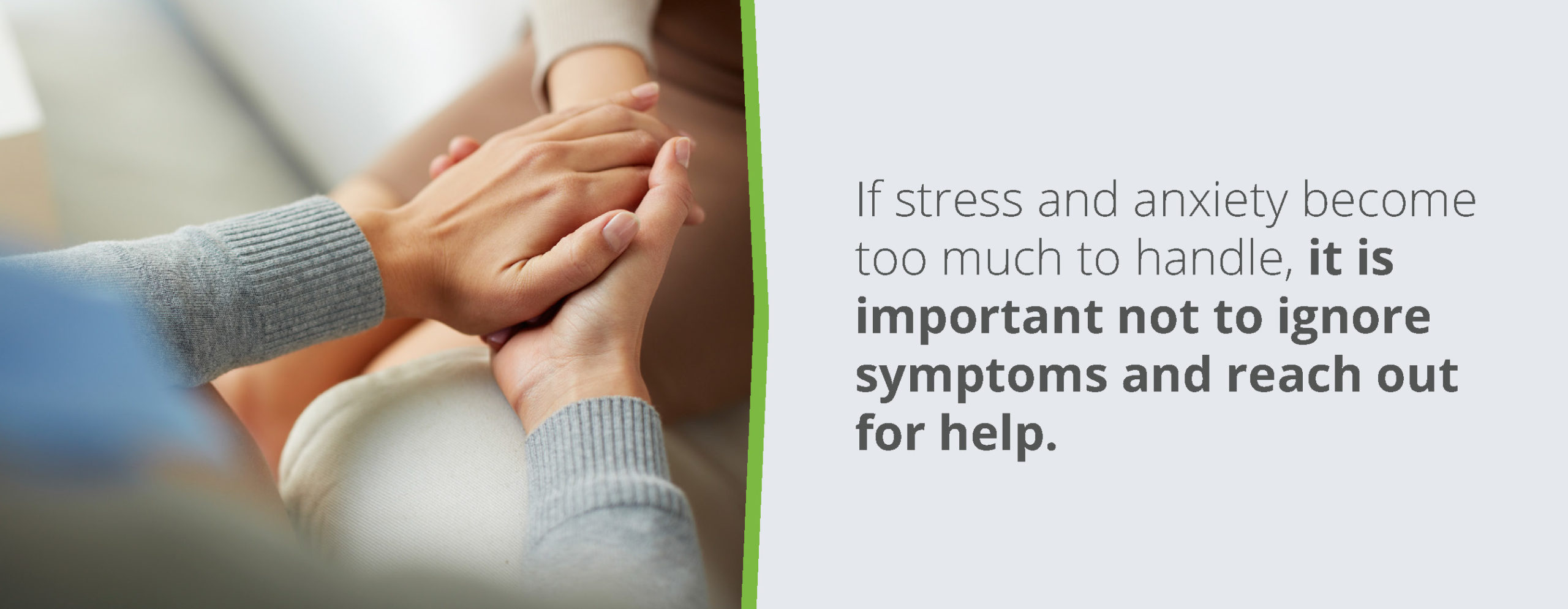Strategies for Reducing Stress, Anxiety and Burnout in the Workplace
Americans experience a lot of pressure in the workplace. With overwhelming workloads and a fear of layoffs, it is no wonder many workers feel bogged down by work-related stress. Many employed individuals carry their work stress home with them and feel like they never get a break.
Stress, anxiety and burnout are terms many of us know too well. According to the 2017 Stress in America survey by the American Psychological Association (APA), 61 percent of Americans claim work as a common source of stress. Chronic stress can have long-term consequences on physical and mental well-being, often causes anxiety and can potentially lead to burnout.
Stress is not an easy word to define or measure. The American Institute of Stress refers to stress as the body’s response to any demand for change.
We all know what stress feels like. Some of us experience heart palpitations, while others get a headache. Our bodies react as if our lives are under threat. Over time, stress can take a toll on us physically and mentally.
Anxiety, on the other hand, is often described as excessive worry and may be a result of stress. Anxious individuals often imagine the “what ifs” of a situation, and experience fear and worry as a result. Both stress and anxiety can produce similar symptoms, such as chest pain or difficulty sleeping.
Finally, burnout is exhaustion resulting from consistently high levels of stress.
Although work-related stress and anxiety are unpleasant feelings, it does not necessarily mean stressed individuals need to find a new job. Fortunately, there are plenty of ways to reduce anxiety at work and keep stress at bay. Once overwhelmed employees learn tips for reducing and managing stress at work, they will be more equipped to prevent burnout.
Causes and Symptoms
Stress, anxiety and burnout affect employees’ lives inside and outside of work. Employees might bring stress home and have less energy to handle personal matters. They may act irritable toward loved ones or feel too drained to enjoy their time outside of work.
In the workplace, stressed-out employees have trouble performing at their best and may struggle to maintain interpersonal relationships. Stress and anxiety influence the company as a whole.
The first step to combating stress and preventing burnout is to know the causes and symptoms. Once employees can identify stressors, they can make necessary changes to reduce stress levels at work and home.
1. Common Causes and Symptoms of Stress at Work
It’s normal and expected to experience stress from time to time at work. After all, work is work for a reason. However, when work-related stress is ongoing and overwhelming, it can have a major impact on life satisfaction and work performance.
Far too many Americans are stressed at work. According to a survey by Harris Interactive:
- Forty-eight percent of workers report having unreasonable deadlines.
- Forty-two percent say job stress interferes with their personal lives.
- Thirty-five percent claim job stress is harming their emotional and physical health.
What else contributes to work-related stress? According to the APA, common causes of stress at work in America include:
- Low pay
- Excessive workload
- Lack of opportunities for growth28%
- Monotonous work
- Lack of social support
- Unclear demands
Symptoms of work-related stress include:
- Headaches
- Stomach pain
- Difficulty concentrating
- Short temper
- Trouble sleeping
Symptoms of chronic stress include:
- Anxiety
- Insomnia
- Depression
- Back pain
- Obesity
- Heart disease
- Diabetes
- High blood pressure
- Weakened immune system
People cope with stress in different ways, and some of them are unhealthy. For example, overwhelmed workers might regularly indulge in sugary foods or excess caffeine to help relieve symptoms of stress. Others might abuse drugs or alcohol to escape stressed feelings and relax. When stress causes an individual to fall into an unhealthy lifestyle, there could be serious health consequences down the road.
2. Common Causes and Symptoms of Anxiety at Work
A survey by the Anxiety and Depression Association of America found 28 percent of American workers have had a panic attack or anxiety, and 30 percent with regular stress have taken prescription medication to manage symptoms related to stress and anxiety. However, only 9 percent had been diagnosed with an anxiety disorder. According to this research, a fair amount of workers are self-medicating as ways to reduce anxiety at work.
Common causes of anxiety at work include:
- Setting and meeting deadlines
- Coping with problems in the workplace
- Maintaining relationships with others
- Managing staff
- Participating in meetings
- Making presentations
- Questioning job security
- Working long hours
- Handling excessive workloads
- Lacking direction
- Experiencing self-doubt
Common symptoms of anxiety include:
- Excessive worrying
- Difficulty sleeping
- Fatigue
- Nervousness
- Sweating
- Trembling
- Heart palpitations
Anxiety not only makes work incredibly uncomfortable for the anxious individual, but it also affects their work performance due to:
- Difficulty working with others
- Trouble concentrating
- Preoccupation with fears and worries
- Refusal to do work because of fear, such as being afraid to speak in front of a group
- Irritability
- Dreading additional stress
3. Common Causes and Symptoms of Burnout at Work
Burnout is commonly associated with helping professions such as nursing. However, all organizations experience the consequences of employee burnout. In a national survey by Kronos Incorporated and Future Workplace, 46 percent of human resource leaders blamed employee burnout for up to half their workforce turnover. According to this survey, here’s what causes burnout.
- Unfair compensation: For 41 percent of survey respondents
- Unreasonable workload: For 32 percent of survey respondents
- Too much overtime: For 32 percent of respondents
Other common causes of burnout, according to the Mayo Clinic, include the following.
- Lack of control: If an employee cannot make decisions at work that affect schedule or workload, they could burn out from related stress.
- Unknown job expectations: When an employee does not know what is expected of them at work, they could become overwhelmed by uncertainty and self-doubt.
- Stressful workplace relationships: When an employee does not feel comfortable around colleagues, they could start to feel emotionally drained.
- Incompatible values: When an employee has different values than the employer, they may feel their work doesn’t have meaning or value.
- Not the right fit: When an employee’s interests and skills do not match the job, they could become stressed over time.
- Too challenging or monotonous: When the work is either too demanding and draining, or too unstimulating for an employee, they could be unable to maintain focus.
- Isolation: When an employee lacks social support at work or outside of work, they could easily become overwhelmed.
- Lack of work-life balance: If work overflows into an employee’s personal life too much, they may not have the energy to enjoy hobbies or relax with friends and recharge.
If someone struggling with burnout fails to address and manage it, symptoms can have an impact on life inside and outside the workplace. Here are some of the symptoms of burnout.
- Exhaustion: A burned-out worker might feel constantly drained, unable to cope with stress and in a bad mood.
- Cynicism: Burnout can cause workers to isolate themselves from other workers or work-related activities. They may feel stressed and frustrated about anything work-related and wish to avoid all activities and people that remind them of work.
- Reduced performance: Employees experiencing burnout may find it hard to focus on their work.
Sufferers of burnout might also experience insomnia or turn to substance abuse to relieve symptoms.
Coping and Management Techniques
Luckily, workplace stress and anxiety do not have to lead to burnout, and there are several coping mechanisms people can learn to prevent burnout and reduce stress and anxiety. Although in some cases it is better to change career paths, many people will find the following tips and strategies helpful in managing stress. Here’s a few tips on how to prevent burnout.
- Practice well-being: Meditation, exercise or other healthy and relaxing activities help lower stress levels. Employers should offer tools and resources to teach employees mindfulness and stress-reduction techniques. Mindfulness helps us gain awareness of our feelings so we can manage them better.
- Know when to disconnect: Too many workers feel like they are always “on” and have trouble disconnecting from work. Employers should make it clear to employees that when work is over, it’s over. Employees need to remind themselves they deserve a healthy work-life balance and that it is OK to set boundaries.
- Practice monotasking over multitasking: Multitasking is not an efficient way to get things done. Instead, practice monotasking, or focusing intensely on one task at a time.
- Be empathetic and compassionate: A workplace that encourages compassion and empathy increases employee performance. Employees feel more comfortable at work and are more engaged when they feel understood and appreciated.
- Keep a stress journal: Employees can record stressors and their reactions to stressors. Once they identify how they react to stress, they can replace unhealthy habits with healthy ones. For example, if an employee heads to the vending machine every time they feel overwhelmed, they might choose to take a brisk walk outside instead.
- Encourage open communication: Too often, employees are afraid to talk about work-related stress and anxiety because they fear they’ll put their job at risk. Instead, employees should know it is safe to talk about their stress and anxiety. By working together, employees and managers can develop individual plans to reduce stress. Some employees can focus on improving time-management skills, while others may need their managers to communicate exactly what is expected of them.
- Address non-productive thinking patterns: A lot of employees experience workplace stress and anxiety due to distorted thinking patterns, according to the career coaching team Jody Michael Associates. Some employees take an all-or-nothing approach and think one bad day means they are a complete failure. Other employees blow things out of proportion, like thinking they will get fired for losing a sale, for example. Others believe what they feel is real. Both employees and employers can discuss and share ideas about non-productive thinking patterns to minimize any unnecessary stress.
- Take breaks: Employers need to allow employees to step away from their desk every day and recharge. Just like children, recess improves productivity, relieves tension and rejuvenates the mind. Encourage employees to take time off occasionally so they can unplug, relax and recharge.
- Get adequate sleep: All adults should aim to get seven to nine hours of sleep a night. Limit pre-bed screen time and caffeine intake throughout the day to help reduce stress and allow for restful sleep.
- Reconsider purpose: Burnout may occur because employees become so overwhelmed with workloads and resulting stress, they lose sight of why they are working in the first place, besides earning a paycheck. Employees should consider the difference they make in the world, and ask themselves if there is anything they can do that would make their work more meaningful.
- Practice positive self-talk: Workers should practice positive thinking and self-talk in the workplace. Positive self-talk helps workers feel more in control of stressful situations. Instead of saying, “I can’t do this,” employees should practice saying, “I can do this.”
When to Get Help
Although employees can manage work stress and anxiety through stress-coping techniques and by creating a healthy work-life balance, sometimes stress becomes too overwhelming and difficult to manage alone. If stress and anxiety become too much to handle, it is important not to ignore symptoms and reach out for help. When symptoms go unaddressed, they can lead to burnout, depression or reduced physical health.
Employees and management should never feel ashamed or embarrassed to reach out to others. It’s time for an employee to seek support if they are:
- Experiencing panic attacks at work
- Self-medicating with drugs, alcohol or food
- Not having success with coping skills
- Having suicidal thoughts
- Experiencing stress or anxiety that is significantly impacting their life and relationships
- Being told by friends, family or coworkers they should get help
Helpful resources include:
- Support groups
- Mental health counselors
- Family and friends
An employee may need medication or therapy to help overcome anxiety and stress and to learn stress-management techniques that work for them.
How Behavioral Health Professionals Can Help
How can behavioral health professionals help stressed or anxious clients? One of the best moves any health care professional can make is to take care of themselves first.
Health care professionals have some of the most stressful jobs imaginable. Doctors and nurses know many patients’ lives depend on them. Therapists and psychologists live in fear they did not help a patient with mental health issues to the best of their ability. Many health care jobs require long shifts and involve unpredictable high-stress situations. It is not uncommon for physicians to experience burnout, for example.
Without sufficient energy, a health care professional may struggle to provide the best patient care. For this reason, all health care professionals need to make self-care a priority.
ICANotes helps reduce stress and restore work-life balance in the workplace so behavioral health professionals can enjoy increased productivity, more time with patients and more moments to recharge.
Our intuitive EHR software makes behavioral health documentation fast and simple. From keeping track of progress notes to getting paid faster with an integrated billing system, behavioral health employees enjoy knowing documentation is complete and accurate with ICANotes.
Instead of spending hours catching up on paperwork or organizing important documents at the end of the day, you can complete necessary tasks with speed and get home to unwind. You’ll be ready to face the next day’s challenges with a renewed perspective.
To learn more about ICANotes, request a free trial, watch our live demo or contact us today for more information.
Related Posts:
10 Foods that Boost Mental Health
Ways Exercise Can Improve Mental Health
Most Common Industries Affected by Mental and Behavioral Health Issues

